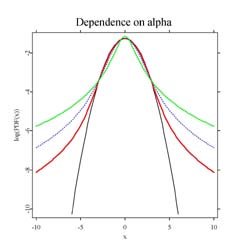Statistical Tools in Finance and Insurance (VL)
- Kategorie
- Master (PhD level)
- Lehrende(r)
- D. Belomestny, E. Giacomini
Description
The course offers an overview of advanced statistical methods in quantitative finance and insurance which should be comprehensible for a graduate student in financial engineering as well as for an inexperienced newcomer who wants to get a grip on advanced statistical tools applied in these fields.Course outline
The course consists naturally of a
finance and insurance part. Each part contains lectures with high focus
on practical applications. The finance starts with an introduction to
stable distributions, which are the standard model for heavy tailed
phenomena. Their numerical implementation is thoroughly discussed and
applications to finance are given. Next lectures present the ideas of
extreme value and copula analysis as applied to multivariate financial
data. This topic is extended in the subsequent lectures which deal with
tail dependence, a concept describing the limiting proportion that one
margin exceeds a certain threshold given that the other margin has
already exceeded that threshold. The next lectures review the market in
catastrophe insurance risk, which emerged in order to facilitate the
direct transfer of reinsurance risk associated with natural
catastrophes from corporations, insurers, and reinsurers to capital
market investors. The next part of the course employs functional data
analysis for the estimation of smooth implied volatility surfaces.
These surfaces are a result of using an oversimplified market benchmark
model - the Black-Scholes formula - to real data. An attractive
approach to overcome this problem is discussed when implied trinomial
trees are applied to modeling implied volatilities and the
corresponding state-price densities. An alternative route to tackling
the implied volatility smile has led researchers to develop stochastic
volatility models. The relative simplicity and the direct link of model
parameters to the market makes Heston's model very attractive to front
office users. Its application to FX option markets is covered in the
next lectures. The following ones show how the computational complexity
of stochastic volatility models can be overcome with the help of the
Fast Fourier Transform. Afterwards the valuation of Mortgage Backed
Securities is discussed in the course. The optimal prepayment policy is
obtained via optimal stopping techniques. It is followed the topic of
predicting corporate bankruptcy with Support Vector Machines. Next
lectures present a novel approach to money-demand modeling using fuzzy
clustering techniques. The first part of the course closes with
productivity analysis for cost and frontier estimation. The
nonparametric Data Envelopment Analysis is applied to efficiency issues
of insurance agencies. The insurance part of the course starts with a
lecture on loss distributions. The basic models for claim severities
are introduced and their statistical properties are thoroughly
explained. During next lectures, the methods of simulating and
visualizing the risk process are discussed.
It is followed the topic of
predicting corporate bankruptcy with Support Vector Machines. Next
lectures present a novel approach to money-demand modeling using fuzzy
clustering techniques. The first part of the course closes with
productivity analysis for cost and frontier estimation. The
nonparametric Data Envelopment Analysis is applied to efficiency issues
of insurance agencies. The insurance part of the course starts with a
lecture on loss distributions. The basic models for claim severities
are introduced and their statistical properties are thoroughly
explained. During next lectures, the methods of simulating and
visualizing the risk process are discussed.  This topic is followed by an
overview of the approaches to approximating the ruin probability of an
insurer. Both finite and infinite time approximations are presented.
Some of these methods are extended during next lectures, where
classical and anomalous diffusion approximations to ruin probability
are discussed and extended to cases when the risk process exhibits good
and bad periods. The last three topics are related to one of the most
important aspects of the insurance business - premium calculation.
First, the basic concepts including the pure risk premium and various
safety loadings under different loss distributions are introduced.
Calculation of a joint premium for a portfolio of insurance policies in
the individual and collective risk models is discussed as well. The
inclusion of deductibles into premium calculation is the next topic
discussed. The last lectures of the insurance part deal with setting
the appropriate level of insurance premium within a broader context of
business decisions, including risk transfer through reinsurance and the
rate of return on capital required to ensure solvability.
This topic is followed by an
overview of the approaches to approximating the ruin probability of an
insurer. Both finite and infinite time approximations are presented.
Some of these methods are extended during next lectures, where
classical and anomalous diffusion approximations to ruin probability
are discussed and extended to cases when the risk process exhibits good
and bad periods. The last three topics are related to one of the most
important aspects of the insurance business - premium calculation.
First, the basic concepts including the pure risk premium and various
safety loadings under different loss distributions are introduced.
Calculation of a joint premium for a portfolio of insurance policies in
the individual and collective risk models is discussed as well. The
inclusion of deductibles into premium calculation is the next topic
discussed. The last lectures of the insurance part deal with setting
the appropriate level of insurance premium within a broader context of
business decisions, including risk transfer through reinsurance and the
rate of return on capital required to ensure solvability.
Literature
- Cizek, Härdle, Weron (2005) "Statistical Tools for Finance and
Insurance" Springer Verlag.
- Härdle, Klinke, Müller (1999) "XploRe Learning Guide, Springer
Verlag"
- Klugman, Panjer and Willmot (1998)Loss Models: From Data to
Decisions, Joh Wiley & Sons.
- Härdle, Simar (2003)Applied Multivariate Statistical Analysis,
Springer Verlag.
- Franke, Härdle, Hafner (2004)Statistics of Financial Markets,
Springer Verlag.
- Härdle, Kleinow, Stahl (2002) Applied Quantitative Finance,
Springer Verlag.
- Härdle, Hlavka, Klinke (2000) XploRe Application Guide, Springer Verlag.
